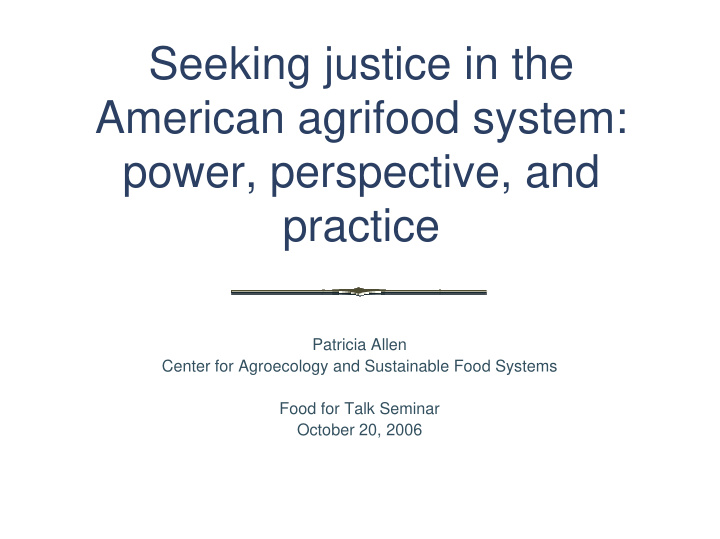



Seeking justice in the Seeking justice in the American agrifood system: American agrifood system: power, perspective, and power, perspective, and practice practice Patricia Allen Patricia Allen Center for Agroecology and Sustainable Food Systems Center for Agroecology and Sustainable Food Systems Food for Talk Seminar Food for Talk Seminar October 20, 2006 October 20, 2006
Food justice issues food insecurity working conditions access to resources exclusive decision making
Discursive turn toward justice � Sustainable agriculture movement � Community food security movement � AFIs, food policy councils, labeling criteria
Seeking justice: perceptions Alternative food institution leaders Consumers University staff, students, faculty
Perceptions: AFI leaders 3/4 of organizations had a position of social justice in the food system 3/4 of leaders said a socially just food system is economically equitable economy equity included fair compensation of labor, common ownership of land, meeting basic needs regardless of ability to pay
Perceptions: consumers What does the term, “socially just food system” mean to you? farmers’ market group: access to food, democratic, community, culturally inclusive upscale grocery store group: access to food, environment, food safety, health discount grocery store group: did not have answer; then discussed experiences of exploitation, pesticide exposure
Perceptions: university 89% said it is important that their food is produced in a socially just manner; willing to pay for justice Important criteria for definition of social justice Highest % Lowest % Equal access to 93 Cap on income 30 education Natural resources 89 Land owned by 25 protection society Basic health care 87 Equal distribution of 25 inherited wealth
Perceptions: summary Interest in social justice in the food system Criteria include economic equity, access to opportunity, health Some indication of willingness to pay for justice
Seeking justice: practice Alternative food institutions Food-system localization Farm-to-school programs
Seeking justice in practice: CSAs and farmers’ markets Farm security and food security? • limited low-income participation • managers interested in food security • managers willing to try new strategies
Seeking justice in practice: CSAs Alternative to market or alternative type of market? � decision making � members and growers � catalyst
Seeking justice in practice: local food campaigns ethical consumption resistance to globalization, QuickTime™ and a None decompressor are needed to see this picture. industrialization locating justice
Seeking justice in practice: farm-to-school � potential � implementation � discourse
Seeking justice in practice: summary � Market-based solutions and entrepreneurialism � Choice and subjects � Community and othering
Hiding justice: challenges � Political power � Material power � Discursive power: ideology and epistemology
Finding justice: tensions alternative and opposition structure and agency systemic forces and contingency
Finding justice: the power of food essential universal—no demographic boundaries structures daily intimate connections one in five American workers works in the food system
Finding justice: convergence � public health and environmental justice movements � AFI leaders � food workers (1 in 5 American workers) � consumers
Finding justice: axes of action comprehensible, succinct definition unifying popular discourse coalition building reflexivity and cognitive praxis actions for productive justice activist-academic workgroups and “think tanks”
Finding justice: definition � A food system in which power and material resources are shared equitably so that people and communities can meet their needs, and live with security and dignity, now and into the future. Developed by Activist Researcher Consortium, January 2004
Finding justice: eye on the ball http://www.ucsc.edu/casf s
Recommend
More recommend